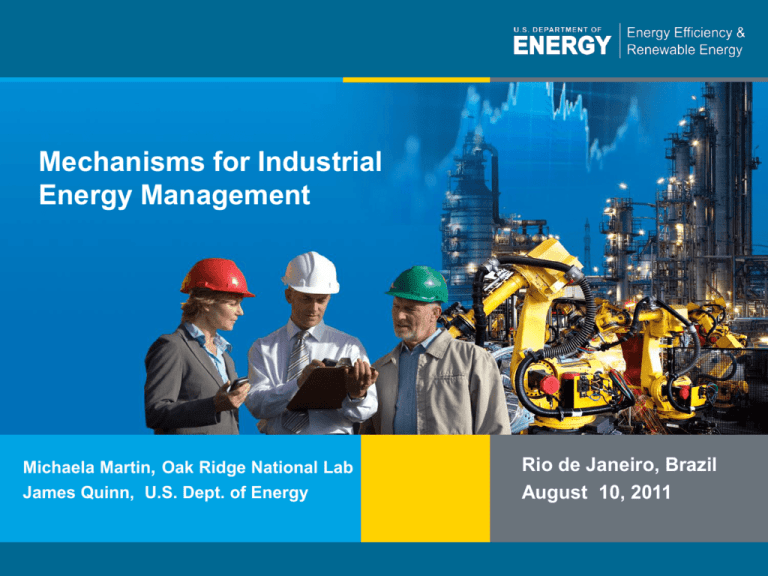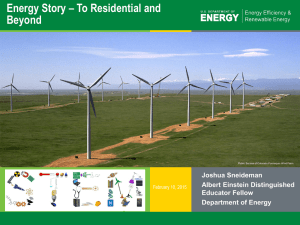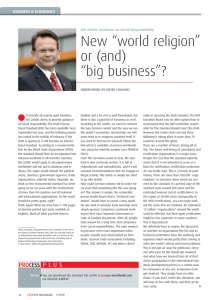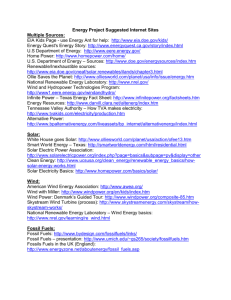Energy Performance Improvement
advertisement

Mechanisms for Industrial Energy Management Michaela Martin, Oak Ridge National Lab James Quinn, U.S. Dept. of Energy Program Name or Ancillary Text Rio de Janeiro, Brazil August 10, 2011 eere.energy.gov What is Energy Management? Energy Management • Is a framework for integrating energy into the existing management practices of an organization • Can be based on a national, or international standard such as ISO 50001- Energy management systems • It requires that: – Top management of an organization make a commitment to continual improvement of their energy performance – Energy performance improvements are measured and documented against a baseline 2 | Industrial Energy Efficiency eere.energy.gov Ad hoc Approach to Energy Management… Source: UNIDO 2010 3 | Industrial Energy Efficiency eere.energy.gov Structured Approach Senior management commit to program Costs +5% Initial savings sustained 0 -5% Housekeeping first – then investment -10% Becomes company culture -15% -20% -25% Investment 0 4 | Industrial Energy Efficiency Years Source: UNIDO 2010 3 eere.energy.gov Benefits of Energy Management • Much of the energy efficiency in existing facilities can be achieved through changes in how energy is managed, rather than through installation of new technologies • Effective energy management also provides a context for management to assess the applicability of new technologies • Energy management requires an organization to comprehensively examine its energy use and consumption and to develop a framework to sustain the change facilities equipment personnel systems processes Scope of an energy management system 5 | Industrial Energy Efficiency eere.energy.gov Building the Case for Energy Management • Identify Champions: – Who are the key person(s) that control needed resources? – Who is respected by staff within the organization? – Who can help you achieve this as a priority? • Identify key persons – Who know the processes – Who know the facilities • Develop a risk response – What are the most common barriers to long-term programs? – Who in the organization is likely to oppose this process? – Are there resource conflicts? – What are the competing priorities? – Who know equipment – Who know how to help team with documents, records, and other management system issues 6 | Industrial Energy Efficiency eere.energy.gov Energy Management Efforts U.S. DOE Efforts to Support Energy Management The U.S. DOE has supported a series of domestic and international efforts to help end-users and their organizations manage energy. • ISO 50001 Energy Management Standard • ASME System Assessment Standards • Resources for Supporting Energy Management • Superior Energy Performance Program • Global Superior Energy Performance (GSEP) Partnership 7 | Industrial Energy Efficiency eere.energy.gov New ISO 50001 Standard ISO 50001 Energy Management Standard • Requires organization to establish a baseline, metrics, energy management team, and system—enabling systematic achievement of continuous improvement in energy performance. • Designed to be used independently, yet can be aligned or integrated with other management systems (e.g., ISO 9001 and ISO 14001). • Applicable to all organizations that use energy, including industrial plants, buildings and other facilities, entire organizations. • Does not prescribe specific energy performance criteria. 8 | Industrial Energy Efficiency eere.energy.gov ISO 50001: Energy Management System Standard ISO 50001 provides a framework for industrial and commercial facilities and organizations to manage their energy use. Potential impacts: • Could influence up to 60% of the world’s energy use across many economic sectors Uptake of ISO 50001 will be driven by companies seeking an internationally recognized response to: ISO 50001 Launched • Developed by ISO Project Committee 242; United States and Brazil led effort with the United Kingdom and China • Corporate sustainability programs • 56 countries participated, 13 as observers • Energy cost reduction initiatives • Final Draft International Standard (FDIS) released March 2011 • Demand created along the manufacturing supply chain • Future national cap and trade programs; carbon or energy taxes; increasing market value of “green manufacturing” / reduced carbon footprint • Final standard published in June 2011. • International climate agreements 9 | Industrial Energy Efficiency eere.energy.gov What’s Different About ISO 50001? Addresses some practical realities: • Energy efficiency is not a core business of most organizations. • Personnel and business priorities change over time. • As a result, energy efficiency improvements may not be sustained. ISO 50001 prepares an organization to: • Manage future organizational changes in an energy-efficient manner, while preserving profitability/effective operations • Evaluate what works for the organization based on hard data and build on it • Provide a structure and framework for communicating results both internally and externally • Integrate an energy management system into existing management programs 10 | Industrial Energy Efficiency eere.energy.gov Components of an Energy Management Standard Typical features include: 1. 2. 3. 4. 5. Energy policy: top management’s official statement of the organization’s commitment to managing energy Cross-divisional management team led by a representative who reports directly to management and is responsible for overseeing implementation of the energy management system Energy review to assess current and planned energy use, energy sources, and consumption and identify opportunities for improvement Baseline of the organization’s energy use Energy performance indicators (EnPIs) that are unique to the company and are tracked to measure progress 11 | Industrial Energy Efficiency eere.energy.gov Components of an Energy Management Standard 6. Energy objectives and targets for energy performance improvement at relevant functions, levels, processes, or facilities within an organization 7. Action plans to meet those targets and objectives 8. Operating controls and procedures for significant energy uses 9. Measurement, management, and documentation for continuous improvement for energy efficiency 10. Internal audit of progress to management based on these measurements 12 | Industrial Energy Efficiency eere.energy.gov ISO 50001 Energy Management (EnMS) ISO FDIS 50001 13 | Industrial Energy Efficiency eere.energy.gov Applying ISO 50001 • Applies to all factors that can be monitored and influenced by the organization to affect energy use • Designed to be used independently, yet can be aligned or integrated with other management systems (e.g., ISO 9001 and ISO 14001). Applicable to all organizations that use energy • Can be implemented at the corporate or facility level • Does not prescribe specific performance criteria or results with respect to energy • Needs enabling policies and programs to realize its global potential • Superior Energy Performance is such an enabling program 14 14 | Industrial Energy Efficiency eere.energy.gov What is Superior Energy Performance? A market-based, ANSI/ANAB-accredited certification program that provides industrial and commercial facilities with a roadmap for achieving continual improvement in energy efficiency while boosting competitiveness. Goals: • Drive continual improvement in energy performance • Develop a transparent system to validate energy performance improvements and management practices • Encourage broad participation throughout industry Superior Energy Performance for industry will be launched in the U.S. in 2012. • Support and build the energy efficiency market and workforce 15 | Industrial Energy Efficiency eere.energy.gov Superior Energy Performance Strategy • Foster a corporate culture of continuous improvement in energy efficiency • Use ISO 50001 standard as foundational tool for energy management • Establish a tiered program that provides an entry point for companies at all levels of experience with energy management • Create a verified record of energy performance improvement. • Potentially create value for corporate energy savings and carbon reductions in utility, state, regional, national, and international trading markets 16 | Industrial Energy Efficiency eere.energy.gov Getting Superior Energy Performance Certified Certification Requirements: An ANSI/ANAB-accredited Verification Body will conduct a third-party audit to verify that the following requirements are met: 1. Energy Management System Conformance to ISO 50001 Energy Management Standard Superior Energy 2. Energy Performance Improvement Performance Single facility ISO 50001 conformance with validated energy performance improvement ISO 50001 is a foundational tool that any organization can use to manage energy. 17 | Industrial Energy Efficiency ISO 50001 Components in place: • Baseline • Policy • Plan • Team/Leader ISO 50001 17 eere.energy.gov Superior Energy Performance Program Design The two-tiered approach accommodates: • Maturity of facility’s energy management program • Level of external validation desired • Business climate/cycle Two Program Tiers Partner Certified Partner Self Declaration ANSI/ANAB-accredited certification Criteria Conformance to ISO 50001 Measure and audit energy performance improvement Criteria Conformance to ISO 50001 Measure, verify, and certify energy performance improvement Performance Levels Energy performance improvement required Performance Levels Energy performance improvement required, minimum requirements set by program Two Pathways Available: Energy Performance or Mature Energy Method of Verifying Results Self Declaration Method of Verifying Results ANSI/ANAB-accredited certification with on-site visit 18 | Industrial Energy Efficiency eere.energy.gov SEP Performance Criteria for Certification Levels Performance Characteristics Energy Energy Performance Performance Pathway Improvement Silver Meets 5% improvement threshold over the last 3 years. Demonstrates an Energy improvement of Performance 15% or more over Improvement the last 10 years. Mature Energy Pathway Score on Best Practice Scorecard Includes credits for energy management best practices and energy performance improvements beyond 15% over the last 10 years. 19 | Industrial Energy Efficiency Gold Meets 15% Meets 10% improvement improvement threshold threshold over the over the last 3 years. last 3 years. Demonstrates an improvement of 15% or more over the last 10 years. Scores at least 35 Scores at least 61 and up to 60 out and up to 80 out of of 100 total points 100 total points for for Best Practice Best Practice Scorecard Scorecard Minimum of 25 points required for the energy management best practices. Platinum Minimum of 25 points required for the energy management best practices and 10 for energy performance. Demonstrates an improvement of 15% or more over the last 10 years. Scores at least 81 out of 100 total points for Best Practice Scorecard Minimum of 25 points required for the energy management best practices and 10 for energy performance. eere.energy.gov 19 Getting Superior Energy Performance Certified Resources to Help Facilities Prepare for Certification Standards & Protocols: Certified Practitioners ISO 50001 Energy Management Standard Certified Practitioner in Energy Management Systems System Assessment Standards Certified Practitioners in [Type] System Measurement & Verification Protocol SEP Lead Auditors SEP Performance Verifiers 20 | Industrial Energy Efficiency eere.energy.gov System Assessment Standards Assessment standards for specific energy systems provide immediate opportunities for energy performance improvement in many facilities. Use of the standards is not required for certification but will help plants define a pathway for achieving energy savings. Available Standards: •Pumping •Compressed Air •Steam •Process Heating Standards cover: • Organizing an assessment • Conducting an assessment • Analyzing the data collected and developing efficiency recommendations • Reporting and documentation Purchase standards and guidance documents from ASME for $35 (print or digital): • http://www.asme.org/kb/standards#des=EA 21 | Industrial Energy Efficiency eere.energy.gov Roles within Superior Energy Performance Industry Government • Drives strategy through U.S. Council for Energy Efficient Manufacturing • Facilitates industry collaboration to develop Superior Energy Performance program: fund program development activities (e.g., standards development, pilot projects) • Pilots elements of Superior Energy Performance prior to program launch • Adopts the Superior Energy Performance program by getting plants certified to ANSI/ANAB-accredited Superior Energy Performance program 22 | Industrial Energy Efficiency • Cost shares Superior Energy Performance program start-up • Leverages Superior Energy Performance program to deploy federal energy programs (e.g., Save Energy Now LEADER) eere.energy.gov U.S. Council for Energy-Efficient Manufacturing • Acts as champion of U.S. industry in pursuing national energy efficiency goals. • Seeks to improve the energy intensity of U.S. manufacturing through a series of initiatives. • Guides development of Superior Energy Performance. 23 | Industrial Energy Efficiency eere.energy.gov Benefits to Companies • Recognition ‒ Publicly recognized as leader in sustainable use of energy resources (local and financial community) ‒ Customers may grant preferred supplier status • External financial incentives ‒ Energy efficiency credits (electric utility & others) ‒ Potential carbon credits (state, region, and national) • Systematic framework for continuous improvement ‒ Consistent with ISO 50001 energy management and ASME system assessment standards ‒ Provides tools and resources to assist implementation and validation of sustained energy performance improvement 24 | Industrial Energy Efficiency Industry and Construction stock CD 01030FRL Creatas Power & Energy CD 005776 eere.energy.gov Market Benefits Benefits in the Industrial and Commercial Energy Efficiency Market • Utilities ‒ Empowers a facility-wide, systems-oriented approach ‒ Helps justify industrial and commercial energy efficiency program investments, including permanent operational changes, to public utility commissions • ESCOs ‒ Builds greater credibility with industrial and commercial customers and a stronger business case for providing third-party energy efficiency services and off-balance sheet capital investments • Supply Chains ‒ Provides a proactive turn-key program for major OEMs and retailers to request their suppliers to meet the program requirements 25 | Industrial Energy Efficiency eere.energy.gov Energy Management Demonstration Projects DOE’s Industrial Technologies Program is conducting State/Regional Energy Management Demonstration Projects. ITP has funded 23 state awards starting in 2009 to help industry save energy. Energy Management Demonstration Goals: • Provide Save Energy Now LEADER Companies with a roadmap to achieve ambitious goals to reduce industrial energy intensity. Kick-Off Dates • Test the elements of Superior Energy Performance. • 2010: Southeast, Midwest, and Mid-Atlantic regions • Build energy management expertise at the regional, state, and plant level by showcasing lessons learned and best practices. • 2011: California, Colorado, and Texas (second round) and Northwest region • 2009: Northwest region • Broaden energy savings throughout the nation. www.eere.energy.gov/industry/energymanagementdemonstrations/ 26 | Industrial Energy Efficiency eere.energy.gov Demonstration Approach 1. The state or region identifies an appropriate demonstration plant based on provided guidelines 2. Facility and consultants receive three face-to-face training sessions 3. Consultants receive monthly training (15-month implementation schedule) 4. Consultants coach facility to implement energy management system in conformance with ISO 50001 5. Facility and consultants hold quarterly review with facility management and Energy Management Demo team lead 6. Facility applies for Superior Energy Performance as early as 18 months after initial training. 27 | Industrial Energy Efficiency PA RT IC I PA NT S Demonstrations • • • • • • • • • • • • • • • • • • • • • • 3M Alcoa Allsteel Amcor PET Bridgestone Tire Cook Composites & Polymers Cooper Tire Didion Milling, Inc Dow Chemical Eaton General Dynamics Gray Harbor Paper Haynes International JR Simplot Kenworth Trucks Neenah Foundry Company Nissan Schneider Electric Spirax Sarco Traco Volvo World Kitchen eere.energy.gov Texas Pilot Project, 2008-2010 DOE worked with the University of Texas at Austin to pilot Superior Energy Performance in Texas facilities: • Field tested elements of Superior Energy Performance • Conducted audits using ANSI MSE and M&V Protocol • Established the first ANSI/ANABaccredited Verification Body for Superior Energy Performance • Certified the first plants to Superior Energy Performance 28 | Industrial Energy Efficiency First facilities certified to Superior Energy Performance Performance Level Cook Composites and Polymers Co. Houston, TX Gold Freescale Semiconductor, Inc. West Austin, TX Silver Owens Corning Waxahachie, TX Silver Union Carbide, subsidiary of the Dow Chemical Co. Texas City, TX (manufacturing facility) Platinum Union Carbide, subsidiary of the Dow Chemical Co. Texas City, TX (energy systems facility) Silver eere.energy.gov Value of Superior Energy Performance Superior Energy Performance provides… • A facility-wide strategic approach to continual energy performance improvement. • Market-recognized validation of effective energy management. Third-party transparency validates energy performance improvement. • SEP M&V Protocol – Offers a standardized methodology for validating energy performance improvements. – Supports project-level M&V. • Supports a more flexible approach by public utility commissions in validating expenditure of rate payer funds. SEP builds energy management expertise in the workforce. • Certified Practitioner credentialing offers an opportunity for states and utility representatives to increase energy management expertise. • Prepares states and utilities to respond to growing interest in energy management. 29 | Industrial Energy Efficiency eere.energy.gov Energy Management System Toolkit • Framework for implementing a comprehensive energy management system • Step-by-step implementation guidance with tools • Web-based and self-paced The Self-Paced Module is located at: https://save-energy-now.org 30 | Industrial Energy Efficiency eere.energy.gov Energy Management System Toolkit DOE will work with utilities and other partners to deliver energy management training to end-users. Four-Part Energy Management Webinar Training series • Helps facilities implement ISO 50001 and Superior Energy Performance requirements. • Supports ITP Energy Management Tool Suite. • Available in October 2011. ITP Energy Management Tool Suite • Identifies savings opportunities and tracks implementation • Basic and advanced levels: − Steam • Tools include: − Process Heating – Quick PEP − Pumps − Fans – Self-Paced Module − Compressed Air – Project Savings Tracker Module − Motors – Carbon Footprint Calculator 31 | Industrial Energy Efficiency eere.energy.gov Global Superior Energy Performance (GSEP) • GSEP is conceived as an international network of national government agencies, national-level certification programs, and other public/private sector organizations that will catalyze continuous energy performance improvements in commercial buildings and industrial facilities of all performance levels. • The GSEP partnership includes Canada, the European Commission, France, India, Japan, Korea, Mexico, Russia, South Africa, Sweden, and the United States. • GSEP was announced in July 2010 at the Clean Energy Ministerial, which convened 25 energy ministers from 20 countries and the European Commission. • Clean Energy Ministerial provided a forum for like-minded countries to take specific steps forward to promote clean energy technologies. • See www.cleanenergyministerial.org/gsep 32 | Industrial Energy Efficiency eere.energy.gov GSEP Objective and Organizational Structure GSEP GSEP objective is to reduce global energy use by: • Encouraging industrial facilities and commercial buildings to pursue continuous improvements in energy efficiency • Promoting public‐private partnership 33 | Industrial Energy Efficiency CERTIFICATION WORKING GROUP (Lead: U.S.) POWER WORKING GROUP (Lead: Japan (P)) CHP WORKING GROUP (Lead: Finland) STEEL WORKING GROUP (Lead: Japan) COOL ROOFS WORKING GROUP (Lead: U.S.) CEMENT WORKING GROUP (Lead: Japan) eere.energy.gov GSEP Partner Countries 34 | Industrial Energy Efficiency eere.energy.gov Certification Working Group The Certification Working Group is developing a network of coordinated, national‐level certification programs to encourage public, educational, and industrial facilities and commercial buildings to pursue continuous improvements in energy efficiency. The GSEP certification process will recognize facilities that meet three main criteria: (1) adoption of an energy management system that conforms with the forthcoming ISO 50001 standard, (2) achievement of a designated minimum rate of energy performance improvement and (3) receipt of third‐party validation of energy performance improvement and conformance to ISO 50001. Industrial GSEP Pilot Participants: 3M, Nissan, Dow Chemical Commercial GSEP Pilot Participants: Cleveland Clinic, Grubb & Ellis Company, Marriott, Target Corp., Walmart 35 | Industrial Energy Efficiency eere.energy.gov Draft GSEP Certification Strategic Objectives, June 2011 Shared Strategic Objectives Defined During GSEP Meeting, 6/20/2011 1. Energy Management. Increase the implementation of energy management in the industrial and buildings sectors to improve energy efficiency and energy performance on an ongoing basis. 2. Measurement and Verification. Measure and verify energy performance improvements on a consistent basis. 3. Qualified Workforce. Build a qualified workforce of professionals with expertise in the fields of energy management, energy efficiency, and measurement and verification. 36 | Industrial Energy Efficiency eere.energy.gov Thank you James Quinn U.S. Dept. of Energy Michaela Martin Oak Ridge National Laboratory 37 | Industrial Energy Efficiency eere.energy.gov





